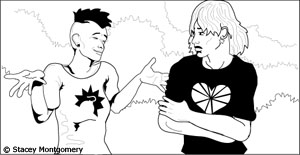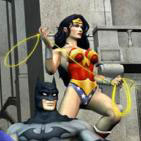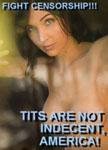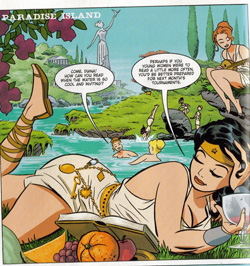Welcome to the Fourth Edition of the Carnival of Feminist Science Fiction and Fantasy Fans! We’ve got quite a collection here this time, a whole host of topics organized by medium: Comic Books and Novels, Film and Television, and (my favourite) Video Games!
Comic Books and Novels

Starting this edition off with a bang are two posts talking about comic books in general. First, reappropriate‘s Jenn entertains us with her post, Meme: the Comic Book version.
Peachblossom of A Libertine‘s post, Feminist Superhero Books, talks about how the issue of feminism in comic books was tackled in the book, Wonder Women: Feminisms and Superheroes, by Lillian s. Robinson.
This one is a bit old, but it’s too good to leave unremarked on. Elkins of Notes from the Tundra examines the very real problem of girl on girl hostility in fandom and the world at large with her post Paranoia in Online Fandom: CMC, Girls’ Aggression, and Overanalyzing the Texts.
My assumption about this paranoia and the behavior that it engenders always used to be that it was simply a side-effect of the nature of CMC itself. The other week, however, while I was at the beach, I read a book someone had recommended to me on the subject of girls’ particular modes of aggression–Odd Girl Out: The Hidden Culture of Aggression in Girls, by Rachel Simmons–and it was really shocking to me just how well many of the things that this book described were things that I strongly associate with online fandom dynamics. That in turn has made me wonder to what extent much of the “paranoiac” behavior that I’ve been seeing in on-line fandom might be an artifact not only of CMC, but also of the predominantly female demographics of the fandom circles in which I’ve travelled.
Ampersand of Alas, a Blog connects this phenomenon to the feminist blogsphere at large in his post, How Girls Express Aggression and Online Fandom Dynamics.
In another instance of relating comics and feminism (this time with a superhero twist), this one Charlie Anders of othermag comments on a talented artist who is using comics as a medium to explore the anti-trans policy of Michfest, a popular women’s festival. The post, Superheroines team up to fight the real enemy, is worth a read, but don’t forget to check out the comic itself as well. It should be noted, however, that since the publishing of the comic, the festival that is alluded to has changed its policy and is now inclusive of all women.
 Moving away from independent comics and into the world of The Big Two, Kalinara of Pretty, Fizzy Paradise says that she can’t find it in her heart to hate someone who brought such a touching moment of female solidarity in Darn You Geoff Johns.
Moving away from independent comics and into the world of The Big Two, Kalinara of Pretty, Fizzy Paradise says that she can’t find it in her heart to hate someone who brought such a touching moment of female solidarity in Darn You Geoff Johns.
In the wake of both the wedding between the X-Men’s Storm and Black Panther, as well as the Black Panel at Comic Con, it’s no surprise that bloggers are still talking about issues surrounding gender and race in comics. Starting us off is Ragnell of Written World and her post, It’s still bothering me…, where she writes about her disappointment in the way that the more popular Storm has taken a back seat to Black Panther. She continues her analysis of this issue over at Newsarama by discussing the implications of the cover art in her post, Amateur Art Appreciation: The Groom
Tackling the issue head on in her livejournal, I’m Sorry I Haven’t A Clue, spiralsheep discusses sexism towards black women in comics in her post, In which our heroine asks, “What would T’Challa do?” , she has this to say:
But when a writer takes an achievement, a genuine victory, away from one character and gives it to another then there’d better be a good reason, when a writer takes away a female character’s self-determination and gives it to the men around her there’d better be a good reason, and when a writer turns a black victim of white crime into a black perpetrator of crime against a white person then there’d better be a !%@%! good reason.
The eponymous blogger Tlönista has written, Rebels from the waist down, a post on the portrayal of women in her favourite dystopian novels:
It gets scary-depressing when you read the feminist blogs and take in a piece on Joe Francis one day and teen virginity pledges the next and realize that the pressures on women in 1984 and Brave New World still exist simultaneously here, so that resisting one is giving into the other.
And what better way to end a section on comic books than with everybody’s favourite hero? Yes, that’s right, Planet Karen has a very special strip about Mars.
Film and Television

Over at Real Men Are Not, Luke dissects an essay on “Fembots” in his post, We’ll Pick You Up: Fembots and the Idiot at Enterprise [eta – broken link removed].
I don’t care if you say that fembots are some male-created extension in science of an already patriarchal culture but don’t tell me that that’s really the “perfect male fantasy”? Talk about something original and actually news-worthy.
Superwomen, not Fembots, are the subject of Ide Cyan’s post over at Feminist SF – The Blog!. In My Super Ex-Girlfriend [Caution! Spoilers in link.] she explores the movie of the same name from a feminist perspective.
The use of oversensitivity to sexual harrassment in the workplace as a running joke is particularly odious and tiresome. In the mouth of the protagonist’s Black, female boss, it adds to the caricature of women in positions of power as unreasonable and unjust towards the poor hapless (White) males.
 And We Shall March laments yet another bastardization of Leguin’s Earthsea series in the post, And Then Ghibli Screwed Earthsea.
And We Shall March laments yet another bastardization of Leguin’s Earthsea series in the post, And Then Ghibli Screwed Earthsea.
What sci-fi carnival would be complete without some Trekkie-loving? First we a post on the original series of Star Trek: heavenscalyx of The Calyx of the Heavens touches on (among other things) the treatment of Marla McGiver in, Khaaaaaaaaaaaaaaan! But TOS isn’t the only of the Star Trek series deserving of attention! On the Hathor Legacy, a blog devoted to the portrayal of women in the media, Revena discusses the fluid gender expression of the character in Star Trek: Deep Space Nine – Jadzia’s Gender.
Kirylin of Kirylin’s Voice muses on Traits of a strong female character, looking at shows like Buffy the Vampire Slayer in contrast with shows of her youth, like G. I. Joe:
Thinking about Elisa; Gloria and Vanessa; Lady Jaye, Scarlett, and Cover Girl; R.C.; Tea and Alexisa… it makes me wonder what defines a “strong” female character.
And to wrap things up with this section, another post from Charlie Anders at othermag: So much for the feminist take on Doctor Who [Caution! Spoilers in link.], which discusses the relationship between the Doctor and his companion.
Video Games

Jeff of our very own Shrub.com kicks off this section by questioning why “feminist video games” didn’t pull up any matches in his post, Feminist Video Games?
Of course, there’s the larger question of what would make a game good from a feminist perspective. In addition to being good from a gameplay perspective, I’d say such a game would include female characters who are full agents in the game world, and who are treated as subjects rather than objects. I think a variation of the Mo Movie Measure applies as well, in that female characters should interact with other female characters in ways that aren’t centered around men.
And, speaking of feminism and games, you know it’s going to spark some controversy when Sony announces that it’s going to release a pink console. Ariel of New Game Plus discusses the politics of pink PS2s and PSPs in her post, Feminists and Pink Game Consoles.
In a more personal expression of feminism and video games, Brinstar of Acid for Blood asks her readers to help her live like a pro-gamer for a weekend in Send Me to Stockholm.
So why do I want to go to Stockholm to learn how to play FPS games with a professional Quake 4 clan? Because it sounds fun. I’d totally blog about it, too. And there would be pictures.
In a less personal post, Brinstar looks at the gender differences in the survivors of a new video game in her post, No Weapons for Women in Dead Rising. While all of the men players have encountered thus far will take a weapon to defend themselves, most women are offered a hand and ushered off to safety. Although I doubt anywhere is truly “safe” when zombies are involved.
And on an unrelated subject, in response to an e-mail I received, I call for readers’ opinions on the where they think the responsibilities of privileged groups lie when choosing avatars in roleplaying games. My post, Race and Video Game Avatars, is on Official Shrub.com Blog and is reproduced over at Alas, A blog, so be sure to check out the discussion at both sites.
Final Words
This concludes the Fourth Edition of the Carnival of Feminist Science Fiction and Fantasy Fans. Ragnell is hurting for hosts, so please e-mail her here and volunteer!


 Another issue that has been overlooked by E3’s ban on booth babes, and apparently any woman atendee whom they deem inappropriate, is that it severely limits women’s ability to cosplay as female characters. Especially female characters in upcoming games.
Another issue that has been overlooked by E3’s ban on booth babes, and apparently any woman atendee whom they deem inappropriate, is that it severely limits women’s ability to cosplay as female characters. Especially female characters in upcoming games.

 So, there’s
So, there’s  Part of my problem with this site is the problem I have with comic books: I believe that the objectification of women here influences the way the consumers of the porn view women. On the one hand, at least this site is honest about wanting to see strong women torn down and humiliated (comics just resort to things like the
Part of my problem with this site is the problem I have with comic books: I believe that the objectification of women here influences the way the consumers of the porn view women. On the one hand, at least this site is honest about wanting to see strong women torn down and humiliated (comics just resort to things like the 


